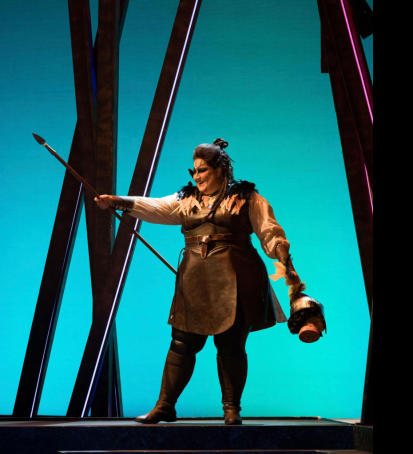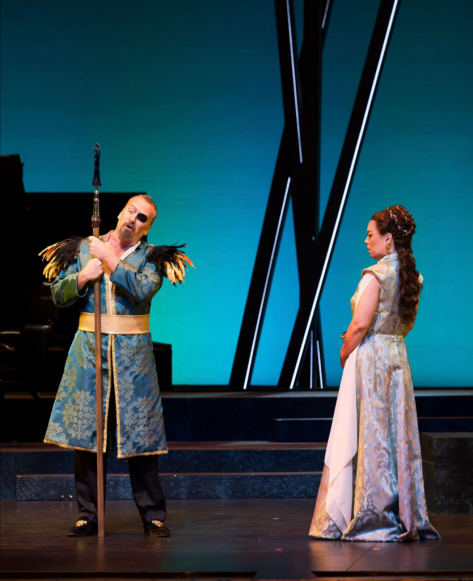Opera Review | Eine Kleine Wagner, at Santa Barbara’s Lobero
Opera Santa Barbara Continues its Abridged Version of Wagner’s Ring Cycle, with a Moving Take on 'The Valkyrie'

Virtually a mythic monster of its own remaking, Wagner’s famed operatic epic “Ring Cycle” (The Ring of the Nibelung) almost invites excess. The last major cycle in Southern California was bravely and extravagantly staged by the L.A. Opera in 2008, with its phantasmagorical production at the hands of Achim Freyer and a price tag of $36 million. Controversies over budget and other issues aside, it was, to these ears, eyes, and senses, an unforgettable and refreshed trip into Wagner’s world, clocking in at about 20 hours, all told.
Such memories serve as a bold, if unfair, comparative measure to the intentionally truncated and load-lightening “Dove” version of the Ring cycle, which Opera Santa Barbara (OSB) has intrepidly ventured into, breaking the Wagner moratorium in Santa Barbara. OSB launched its version of the abridged and more practical Ring, created by Jonathan Dove in 1990 and in circulation around the world, with Das Rheingold in 2021, and continued with The Valkyrie (Die Walküre), last Sunday at the Lobero Theatre.
If this tightened-up abridgment, about half the opera’s typical five-ish hour length, was less than true to Wagner’s original mission, it nonetheless served as a substantial finale to one of Opera Santa Barbara’s more adventurous seasons in its nearly 30-year run so far.
With Wagnerian excess being impossible here, the production leaned creatively in the direction of resourceful reductivism to get the job done. The compact orchestral ensemble — nimbly conducted by OSB head Kostis Protopapas — sat on stage right, percussionist Jon Nathan perched across the Lobero stage, an outer flank to the dramatic and vocal action. A spare staging — directed by Crystal Manich and with scenic and lightings designs by François-Pierre Couture — made effective use of lighting and angular tilted elements variously implying sabers, a protective fire, and generally upping the ante of psychic tension naturally embedded in this operatic tale. By contrast, Azucena Dominguez’s costumes heeded Ring standards, conservatively and splendidly.

Family matters are taken to various extremes in the The Valkyrie, from the semi-incestuous romance between Siegmund and Seigfried in the human realm to the alternately tender and fractious father-daughter dynamics between the God Wotan and his offspring Brünhilde (the baddest of the Valkyries) in Valhalla, land of the Gods. In some way, the narrative thread and flow of the tale in this chapter, actually benefits from the trimmer dimensions. The story and intricate relational details become more lucid and intimate, just as the central musical themes seem clearer in the stripped-down orchestral arrangement.
And then there is “the ride.” Wagner’s driving “Ride of the Valkyries” theme, which first asserts itself in Act 2 and bumps up some notches in Act 3, cannot help but trigger visions of the cowboy-hatted Robert Duvall in Apocalypse Now, or Bugs Bunny. The theme has been tagged and perhaps tainted by 20th century pop cultural references, but the effect also lends a populist appreciation to at least this stop in the four-opera cycle. Pop culture fizz was nowhere to be found while we basked in the thrill of hearing the Valkyries (Sunwoo Park, Christina Pezzarossi, and Georgia Jacobson) in taut harmonies while in the thrall of “the ride.”
Ultimately, what made this production work as well as it did was the fact that the Wagnerian-equipped singers made it all, well, sing. The role of Wotan seized a special spotlight in this installment of the cycle, and bass-baritone Wayne Tigges dealt with the technical and conflicted emotional challenges of the role with a scene-stealing bravura. Alexandra Loutsion’s Brünhilde was commanding and nuanced, suiting the complex character, climaxing in the surprisingly lyrical and dreamy finale of Wagner’s score, and her sleepy, fire-protected banishment to the mortal world.
Granted their spotlight in the stage-setting first act, impressive singers Robert Stahley and Julie Davis made for an empathetic duo in the roles of magnetically-connected siblings Siegmund and Sieglinde, soon expecting Siegfried — subject of the next Ring chapter. Returning OSB singers included Santa Barbara-bred Nina Yoshida (impactful in this season’s An American Dream) and current Santa Barbaran Colin Ramsey, in the secondary spousal roles of Valhallan Fricka and human realm citizen Hunding.
We may have missed the sensation of plunging into the full measure of Wagner’s “gesamtkunstwerk” (“total artwork”) intensity in the “Dove Ring,” but we got many of the attached pleasures and performance highs, in a small plate fashion. Another positive upshot: Protopapas’s OSB has succeeded in making the 805 safe for the Ring.




You must be logged in to post a comment.